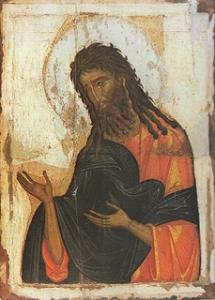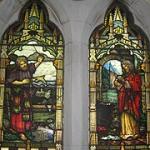
The real Christmas story did not begin with shepherds and a manger. It began in the depths of eternity, when this earth was in its planning stages. It required perfect preparation including Jesus Christ and one who was to come immediately before Him to provide doctrine and followers on whom His work could be based.
“Can one possibly imagine John the Baptist without Jesus? What would the Savior’s mission have been like without the preparatory work performed by John?” asked Gèrald Caussé. He continued, “John the Baptist was given one of the most noble missions to ever exist: ‘to prepare the way of the Lord,’ to baptize Him with water, and to make ready a people to receive Him.”
Is perfect preparation possible? Not for those struggling with messy mortality. But Jesus Christ and John the Baptist were not mortal planners when they looked toward and prepared for what they would do on earth.
Sacred Promises
John, like Jesus, was a child of promise. Zacharias and Elisabeth were “both righteous before God,” obeying His commandments and ordinances “blameless.” For once in his lifetime Zacharias was to “execute the priest’s office” in the temple; his turn arrived nine months before John needed to be born. As he was burning incense, with a “multitude” praying outside, something happened inside that the multitude could not see. Angel Gabriel appeared to the right of the altar. Being human, Zacharias was frightened.
Gabriel’s message troubled him even more. He and Elisabeth were childless and well past the age of being able to become parents. But the angel was promising him that they would have a son, and he was very specific that his name should be John. The message became even more specific and puzzling:
For he shall be great in the sight of the Lord . . . and he shall be filled with the Holy Ghost, even from his mother’s womb. And many of the children of Israel shall he turn to the Lord their God. (Luke 1:15-16)
That was one impossibility followed by several others, and Zacharias wanted proof: “Whereby shall I know this?” Asking for a sign can be risky: Zacharias would not be able to speak until after the child’s birth. In contrast, Elisabeth was thrilled about her miracle child.
Promises Fulfilled
The perfect preparation blessed Mary and Elisabeth with each other. When Mary learned that she was to be the mother of the Savior of the World, she needed someone to understand what she was going through spiritually, emotionally, mentally, and in every other way. But no one could do this, because no one had ever (or would ever) experience it. Elisabeth, her cousin, was coming as close as anyone else could. In her faith, Elisabeth welcomed the promise of Gabriel, though she probably felt her age as much as Zacharias did (if not more).
As Mary came into Elisabeth’s home, Elisabeth’s unborn baby was so eager that he “leaped,” and “Elisabeth was filled with the Holy Ghost.” She spoke loudly, “Blessed are thou among women and blessed is the fruit of thy womb.” Mary stayed with Elisabeth three months (Luke 1:40-44).
At John’s birth, promises and prophesies were fulfilled, and Zacharias was again able to speak—which he did eloquently.
With Herod’s wicked decree for destroying young children, John was taken by his mother into a desert. He was dressed in rough clothing and fed on locusts and wild honey. As Luke recorded, “The child grew, and waxed strong in spirit, and was in the deserts till the day of his shewing unto Israel” (Luke 1:80). His life is evidence that under Elisabeth’s love and direction he became physically, mentally, emotionally—and especially spiritually—strong (see Luke 1:80).
A Startling Presence
As he was first showed to Israel, John the Baptist was a startling sight. He was dressed in camel hair and girded about the loins with leather (see Matthew 3:1-12). He was obviously a little rough around the edges, but his heart was gold. And people flocked to the Judaean wilderness to see, hear, and be baptized by him. As Jesus explained to a questioning crowd,
What went ye out for to see? A prophet? yea, I say unto you . . . more than a prophet . . . Among them that are born of women, there hath not risen a greater than John the Baptist . . . and if ye will receive it, this is [the] Elias [forerunner] which was for to come.
Personally, John was a humble, gentle, even self-effacing man, but his words were firm and strong: in Isaiah’s words, “the voice of one crying in the wilderness, Prepare ye the way of the Lord, make his paths straight” (Matthew 3:3). And when some Sadducees and Pharisees slipped into the crowd, he came out in full power:
O generation of vipers, who hath warned you to flee from the wrath to come? . . .
And now also the axe is laid unto the root of the trees: therefore every tree which bringeth not forth good fruit is hewn down, and cast into the fire . . . [He who is to come] will throughly purge his floor, and gather his wheat into the garner; but he will burn up the chaff with unquenchable fire.
Humble Perfection
Before John the Baptist, Israel had not had a prophet for more than 400 years, and the people had been moving into competitive groups. The perfect preparation of John was badly needed to ease the Savior’s work. John recognized his role and took it seriously. He taught the basic principles people needed to know and remember (see Matthew 3; Luke 3).
John the Baptist was among the most humble of prophets; he adapted a popular metaphor: “He that hath the bride is the bridegroom: but the friend of the bridegroom, which standeth and heareth him, rejoiceth greatly because of the bridegroom’s voice: this my joy therefore is fulfilled.” John baptized many who were to go to the Savior, including two of His apostles, John and Andrew.
President Thomas S. Monson gave us this perspective: “John the Baptist provides for us a flawless example of unfeigned humility, as he deferred always to the One who was to follow—the Savior of mankind.” John was privileged to perform the most significant baptism of all time.
“Reverently, but audible enough for those nearby to hear, John uttered the admiration that still moves us two millennia later: ‘Behold the Lamb of God,'” as expressed by Jeffrey R. Holland.
Elder Holland taught,
John chose the earliest and perhaps most commonly recognized image in the religious tradition of his people . . . the figure of a sacrificial lamb offered in atonement for the sins and sorrows of a fallen world and all the fallen people in it.
Humbly, John was surprised when Jesus asked him for baptism: “I have need to be baptized of thee, and comest thou to me?”( Matthew 3:14). In perfect obedience, John did as the Savior asked.
The world might consider John’s death tragic—a wicked ruler tricked by his wicked daughter. As typical, John had refused to condone their wickedness. Knowing that John was returning to his important eternal work, we are blessed to think of it in terms of joyful continuation.
(Painting from 14th Century, artist unknown/Wikimedia Commons)













